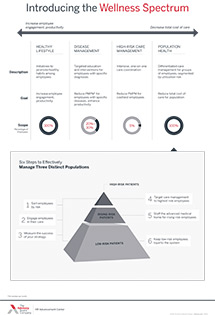Hawaii is healthiest U.S. state, according to the United Health Foundation's (UHF) latest America's Health Rankings report.
Methodology
UHF for its 2018 America's Health Rankings report considered 35 health care measures that account for:
- Behaviors, including drug overdose deaths, alcohol misuse, and physical inactivity;
- Clinical care, including preventable hospitalizations among Medicare beneficiaries, the number of primary care physicians, and the number of dentists;
- Community and environment, including air pollution, childhood poverty levels, and infectious disease cases;
- Policies, including those related to immunizations and public health funding; and
- Outcomes, including cancer deaths, cardiovascular deaths, and health disparities.
The report is based on data from CDC, the U.S. Census Bureau, and other federal agencies.
The United Health Foundation is one of UnitedHealth Group's philanthropic foundations. Daily Briefing is published by Advisory Board, a division of Optum, which is a wholly owned subsidiary of UnitedHealth Group.
State rankings
The report ranked Hawaii as the healthiest state in the country, unseating Massachusetts, which ranked as the healthiest state in 2017's rankings. Hawaii had held the top spot for five consecutive years until 2017.
According to the report, the next healthiest states included:
- Massachusetts, which ranked second;
- Connecticut, which ranked third;
- Vermont, which ranked fourth; and
- Utah, which ranked fifth.
According to the rankings, the five least healthy states in the United States were:
- Arkansas, which ranked 46th;
- Oklahoma, which ranked 47th;
- Alabama, which ranked 48th;
- Mississippi, which ranked 49th; and
- Louisiana, which ranked 50th.
The report stated that Maine experienced the largest improvement in its overall ranking, jumping seven spots to 16th. California and North Dakota also saw significant bumps, with both jumping five spots to 12th and 13th, respectively.
Oklahoma saw the largest decline, falling four places to 47th. According to the report, the drop was largely due to changes in health behaviors among the states' residents, including an 11% increase in obesity prevalence and a 14% increase in the state's physical inactivity rate over the past year.
The report also found a "record-breaking prevalence of obesity and rising mortality rates," which "present significant health challenges for the country." Specifically, the report found that the nation's obesity rate rose by 5% from 2017 to 2018, and continued to be a leading cause of cardiovascular disease and cancer.
In addition, despite a continued decline in the national cancer rate, the report found that more than 30 states either saw increases in their cancer death rates or did not see significant improvements in those rates.
Further, the United States' premature death rate increased for the fourth straight year, largely due to deaths from chronic diseases, suicide, and drug-related overdose deaths. For example, the report found that the national rate of drug-related deaths increased by 25% from 2017 to 2018.
UHF also discovered "concerning mental health challenges impacting the nation." For example, the report found that the national suicide rate increased by 16% from 2012 to 2018. In addition, the report noted an increase in the number of Americans reporting poor mental health. Further, self-reported mental distress rose by 7% from 2016 to 2018, the report found.
The report also found that the national child poverty level declined by 6% nationwide from 2017 to 2018 and has decreased by 19% over the past five years. However, the reduction in child poverty was not even across all geographic areas, the report found. For example, Louisiana has a child poverty rate of 28%—almost triple New Hampshire's rate of 10.3% (Goldberg, "Pulse," Politico, 12/12; United Health Foundation, America's Health Rankings, December 2018)
Understand the wellness spectrum—and promote healthy habits at work
Programs aimed at promoting healthy habits among employees are likely to lead to improved employee engagement and productivity—but they're unlikely to reduce the total cost of care. To do that, you'll need to take a population health approach.
Don't miss out on the latest Advisory Board insights
Create your free account to access 1 resource, including the latest research and webinars.
Want access without creating an account?
You have 1 free members-only resource remaining this month.
1 free members-only resources remaining
1 free members-only resources remaining
You've reached your limit of free insights
Become a member to access all of Advisory Board's resources, events, and experts
Never miss out on the latest innovative health care content tailored to you.
Benefits include:
You've reached your limit of free insights
Become a member to access all of Advisory Board's resources, events, and experts
Never miss out on the latest innovative health care content tailored to you.
Benefits include:
This content is available through your Curated Research partnership with Advisory Board. Click on ‘view this resource’ to read the full piece
Email ask@advisory.com to learn more
Click on ‘Become a Member’ to learn about the benefits of a Full-Access partnership with Advisory Board
Never miss out on the latest innovative health care content tailored to you.



